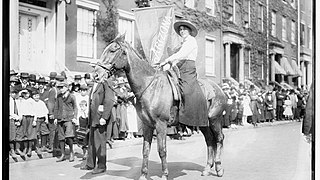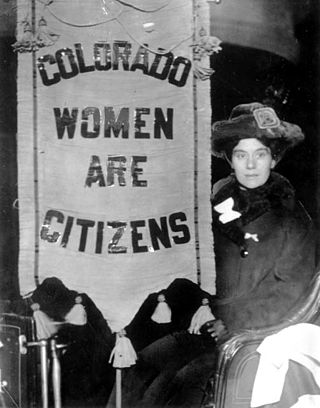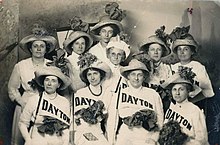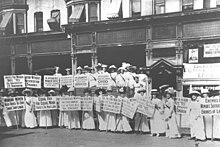The Constitution of the State of Ohio is the basic governing document of the State of Ohio, which in 1803 became the 17th state to join the United States of America. Ohio has had three constitutions since statehood was granted.
This timeline highlights milestones in women's suffrage in the United States, particularly the right of women to vote in elections at federal and state levels.

Women's suffrage was established in the United States on a full or partial basis by various towns, counties, states, and territories during the latter decades of the 19th century and early part of the 20th century. As women received the right to vote in some places, they began running for public office and gaining positions as school board members, county clerks, state legislators, judges, and, in the case of Jeannette Rankin, as a member of Congress.

Women's rights issues in Ohio were put into the public eye in the early 1850s. Women inspired by the Declaration of Rights and Sentiments at the 1848 Seneca Falls Convention created newspapers and then set up their own conventions, including the 1850 Ohio Women's Rights Convention which was the first women's right's convention outside of New York and the first that was planned and run solely by women. These early efforts towards women's suffrage affected people in other states and helped energize the women's suffrage movement in Ohio. Women's rights groups formed throughout the state, with the Ohio Women's Rights Association (OWRA) founded in 1853. Other local women's suffrage groups are formed in the late 1860s. In 1894, women won the right to vote in school board elections in Ohio. The National American Woman Suffrage Association (NAWSA) was headquartered for a time in Warren, Ohio. Two efforts to vote on a constitutional amendment, one in 1912 and the other 1914 were unsuccessful, but drew national attention to women's suffrage. In 1916, women in East Cleveland gained the right to vote in municipal elections. A year later, women in Lakewood, Ohio and Columbus were given the right to vote in municipal elections. Also in 1917, the Reynolds Bill, which would allow women to vote in the next presidential election was passed, and then quickly repealed by a voter referendum sponsored by special-interest groups. On June 16, 1919, Ohio became the fifth state to ratify the Nineteenth Amendment.

This is a timeline of women's suffrage in Missouri. Women's suffrage in Missouri started in earnest after the Civil War. In 1867, one of the first women's suffrage groups in the U.S. was formed, called the Woman Suffrage Association of Missouri. Suffragists in Missouri held conventions, lobbied the Missouri General Assembly and challenged the Supreme Court of the United States (SCOTUS). The case that went to SCOTUS in 1874, Minor v. Happersett was not ruled in the suffragists' favor. Instead of challenging the courts for suffrage, Missouri suffragists continued to lobby for changes in legislation. In April 1919, they gained the right to vote in presidential elections. On July 3, 1919, Missouri becomes the eleventh state to ratify the Nineteenth Amendment.

This is a timeline of women's suffrage in Rhode Island. Women's suffrage in Rhode Island started with women's rights activities, such as convention planning and publications of women's rights journals. The first women's suffrage group in Rhode Island was founded in 1868. A women's suffrage amendment was decided by referendum on April 6, 1887, but it failed by a large amount. Finally, in 1917, Rhode Island women gained the right to vote in presidential elections. On January 6, 1920, Rhode Island became the twenty-fourth state to ratify the Nineteenth Amendment.

This is a timeline of women's suffrage in Montana. The fight for women's suffrage in Montana started earlier, before even Montana became a state. In 1887, women gained the right to vote in school board elections and on tax issues. In the years that followed, women battled for full, equal suffrage, which culminated in a year-long campaign in 1914 when they became one of eleven states with equal voting rights for most women. Montana ratified the Nineteenth Amendment on August 2, 1919 and was the thirteenth state to ratify. Native American women voters did not have equal rights to vote until 1924.

The women's suffrage movement in Montana started while it was still a territory. The Women's Christian Temperance Union (WCTU) was an early organizer that supported suffrage in the state, arriving in 1883. Women were given the right to vote in school board elections and on tax issues in 1887. When the state constitutional convention was held in 1889, Clara McAdow and Perry McAdow invited suffragist Henry Blackwell to speak to the delegates about equal women's suffrage. While that proposition did not pass, women retained their right to vote in school and tax elections as Montana became a state. In 1895, National American Woman Suffrage Association (NAWSA) came to Montana to organize local groups. Montana suffragists held a convention and created the Montana Woman's Suffrage Association (MWSA). Suffragists continued to organize, hold conventions and lobby the Montana Legislature for women's suffrage through the end of the nineteenth century. In the early twentieth century, Jeannette Rankin became a driving force around the women's suffrage movement in Montana. By January 1913, a women's suffrage bill had passed the Montana Legislature and went out as a referendum. Suffragists launched an all-out campaign leading up to the vote. They traveled throughout Montana giving speeches and holding rallies. They sent out thousands of letters and printed thousands of pamphlets and journals to hand out. Suffragists set up booths at the Montana State Fair and they held parades. Finally, after a somewhat contested election on November 3, 1914, the suffragists won the vote. Montana became one of eleven states with equal suffrage for most women. When the Nineteenth Amendment was passed, Montana ratified it on August 2, 1919. It wasn't until 1924 with the passage of the Indian Citizenship Act that Native American women gained the right to vote.

This is a timeline of women's suffrage in Nevada. In 1869, Curtis J. Hillyer introduced a women's suffrage resolution in the Nevada Legislature which passed, though it would wait for another legislative session to approve a second time. The first women's suffrage convention took place in 1870 in Battle Mountain Station. Several women's suffrage resolutions are voted on, or approved, but none complete the criteria to become amendments to the Constitution of Nevada. In the 1880s, women gain the right to run for school offices and several women run and win. Some Nevada women's suffrage groups work throughout the 1890s and hold more conventions. However, most suffrage work slows down or stops around 1899. The Nevada Equal Franchise Society (NEFS) was created in 1911. That same year, Attorney Felice Cohn writes a women's suffrage resolution that is accepted and passed by the Nevada Legislature. Anne Henrietta Martin becomes president of NEFS in 1912. The next year, Cohn's resolution passes a second time and will go out as a voter referendum the next year. On November 3, 1914 Nevada voters approve women's suffrage. Women in Nevada continue to be involved in suffrage campaigning. On February 7, 1920 Nevada ratifies the Nineteenth Amendment.

The movement for women's suffrage in Arizona began in the late 1800s. After women's suffrage was narrowly voted down at the 1891 Arizona Constitutional Convention, prominent suffragettes such as Josephine Brawley Hughes and Laura M. Johns formed the Arizona Suffrage Association and began touring the state campaigning for women's right to vote. Momentum built throughout the decade, and after a strenuous campaign in 1903, a woman's suffrage bill passed both houses of the legislature but was ultimately vetoed by Governor Alexander Oswald Brodie.

This is a timeline of women's suffrage in Arizona. The first women's suffrage bill was brought forward in the Arizona Territorial legislature in 1883, but it did not pass. Suffragists work to influence the Territorial Constitutional Convention in 1891 and lose the women's suffrage battle by only three votes. That year, the Arizona Suffrage Association is formed. In 1897, taxpaying women gain the right to vote in school board elections. Suffragists both from Arizona and around the country continue to lobby the territorial legislature and organize women's suffrage groups. In 1903, a women's suffrage bill passes, but is vetoed by the governor. In 1910, suffragists work to influence the Arizona State Constitutional Convention, but are also unsuccessful. When Arizona becomes a state on February 14, 1912, an attempt to legislate a women's suffrage amendment to the Arizona Constitution fails. Frances Munds mounts a successful ballot initiative campaign. On November 5, 1912, women's suffrage passes in Arizona. In 1913, the voter registration books are opened to women. In 1914, women participate in their first primary elections. Arizona ratified the Nineteenth Amendment on February 12, 1920. However, Native American women and Latinas would wait longer for full voting rights.

This is a timeline of women's suffrage in Maine. Suffragists began campaigning in Maine in the mid 1850s. A lecture series was started by Ann F. Jarvis Greely and other women in Ellsworth, Maine in 1857. The first women's suffrage petition to the Maine Legislature was sent that same year. Women continue to fight for equal suffrage throughout the 1860s and 1870s. The Maine Woman Suffrage Association (MWSA) is established in 1873 and the next year, the first Woman's Christian Temperance Union (WCTU) chapter was started. In 1887, the Maine Legislature votes on a women's suffrage amendment to the state constitution, but it does not receive the necessary two-thirds vote. Additional attempts to pass women's suffrage legislation receives similar treatment throughout the rest of the century. In the twentieth century, suffragists continue to organize and meet. Several suffrage groups form, including the Maine chapter of the College Equal Suffrage League in 1914 and the Men's Equal Suffrage League of Maine in 1914. In 1917, a voter referendum on women's suffrage is scheduled for September 10, but fails at the polls. On November 5, 1919 Maine ratifies the Nineteenth Amendment. On September 13, 1920, most women in Maine are able to vote. Native Americans in Maine are barred from voting for many years. In 1924, Native Americans became American citizens. In 1954, a voter referendum for Native American voting rights passes. The next year, Lucy Nicolar Poolaw (Penobscot), is the Native American living on an Indian reservation to cast a vote.

This is a timeline of women's suffrage in Arkansas. Early suffrage efforts date back to 1868 when Miles Ledford Langley tries to add a women's suffrage law in the state constitutional convention. The first women's suffrage organization in the state was created by Lizzie Dorman Fyler in 1881 and lasts until 1885. Another suffrage group is started in 1888 by Clara McDiarmid. Women's suffrage work continues steadily, though slowed down until the 1910s. New suffrage organizations began to form and campaigned for women's suffrage legislation. In 1917, women earned the right to vote in state primary elections. In May 1918 between 40,000 and 50,000 voted for the first time in Arkansas' primaries. On July 28, 1919 Arkansas ratified the Nineteenth Amendment. On December 3, 1919 the League of Women Voters (LWV) of Arkansas was formed.

In 1893, Colorado became the second state in the United States to grant women's suffrage and the first to do so through a voter referendum. Even while Colorado was a territory, lawmakers and other leaders tried to include women's suffrage in laws and later in the state constitution. The constitution did give women the right to vote in school board elections. The first voter referendum campaign was held in 1877. The Woman Suffrage Association of Colorado worked to encourage people to vote yes. Nationally-known suffragists, such as Susan B. Anthony and Lucy Stone spoke alongside Colorado's own Alida Avery around the state. Despite the efforts to influence voters, the referendum failed. Suffragists continued to grow support for women's right to vote. They exercised their right to vote in school board elections and ran for office. In 1893, another campaign for women's suffrage took place. Both Black and white suffragists worked to influence voters, gave speeches, and turned out on election day in a last-minute push. The effort was successful and women earned equal suffrage. In 1894, Colorado again made history by electing three women to the Colorado house of representatives. After gaining the right to vote, Colorado women continued to fight for suffrage in other states. Some women became members of the Congressional Union (CU) and pushed for a federal suffrage amendment. Colorado women also used their right to vote to pass reforms in the state and to support women candidates.

This is a timeline of women's suffrage in Colorado. Women's suffrage efforts started in the late 1860s. During the state constitutional convention for Colorado, women received a small win when they were granted the right to vote in school board elections. In 1877, the first women's suffrage referendum was defeated. In 1893, another referendum was successful. After winning the right to vote, Colorado women continued to fight for a federal women's suffrage amendment. While most women were able to vote, it wasn't until 1970 that Native Americans living on reservations were enfranchised.

Women's suffrage began in North Dakota when it was still part of the Dakota Territory. During this time activists worked for women's suffrage, and in 1879, women gained the right to vote at school meetings. This was formalized in 1883 when the legislature passed a law where women would use separate ballots for their votes on school-related issues. When North Dakota was writing its state constitution, efforts were made to include equal suffrage for women, but women were only able to retain their right to vote for school issues. An abortive effort to provide equal suffrage happened in 1893, when the state legislature passed equal suffrage for women. However, the bill was "lost," never signed and eventually expunged from the record. Suffragists continued to hold conventions, raise awareness, and form organizations. The arrival of Sylvia Pankhurst in February 1912 stimulated the creation of more groups, including the statewide Votes for Women League. In 1914, there was a voter referendum on women's suffrage, but it did not pass. In 1917, limited suffrage bills for municipal and presidential suffrage were signed into law. On December 1, 1919, North Dakota became the twentieth state to ratify the Nineteenth Amendment.

Women's suffrage started in South Dakota when it was part of Dakota Territory. Prior to 1889, it had a shared history of women's suffrage with North Dakota. While South Dakota was part of the territory, women earned the right to vote on school related issues. They retained this right after it became a separate state. The state constitution specified that there would be a women's suffrage amendment referendum in 1890. Despite a large campaign that included Susan B. Anthony and a state suffrage group, the South Dakota Equal Suffrage Association (SDESA), the referendum failed. The state legislature passed additional suffrage referendums over the years, but each was voted down until 1918. South Dakota was an early ratifier of the Nineteenth Amendment, which was approved during a special midnight legislative session on December 4, 1919.

Efforts toward women's suffrage began early in Iowa's history. During the territory's Constitutional Convention, discussions on both African American and women's suffrage took place. Early on, women's rights were discussed in the state by women such as Amelia Bloomer and petitions for suffrage were sent to the Iowa state legislature. While African American men earned the right to vote in 1868, women from all backgrounds had to continue to agitate for enfranchisement. One of the first suffrage groups was formed in Dubuque in 1869. Not long after, a state suffrage convention was held in Mount Pleasant in 1870. Iowa suffragists focused on organizing and lobbying the state legislature. In 1894, women gained the right to vote on municipal bond and tax issues and also in school elections. These rights were immediately utilized by women who turned out in good numbers to vote on these issues. By the 1910s, the state legislature finally passed in successive sessions a women's suffrage amendment to the state constitution. This resulted in a voter referendum to be held on the issue on June 5, 1916. The campaign included anti-suffrage agitation from liquor interests who claimed that women's suffrage would cause higher taxes. The amendment was defeated, though a subsequent investigation turned up a large amount of fraud. However, the election could not be invalidated and women had to wait to vote. On July 2, 1919, Iowa became the tenth state to ratify the Nineteenth Amendment.

This is a timeline of women's suffrage in Iowa. Women's suffrage work started early in Iowa's history. Organizing began in the late 1960s with the first state suffrage convention taking place in 1870. In the 1890s, women gained the right to vote on municipal bonds, tax efforts and school-related issues. By 1916, a state suffrage amendment went to out to a voter referendum, which failed. Iowa was the tenth state to ratify the Nineteenth Amendment in 1919.





















